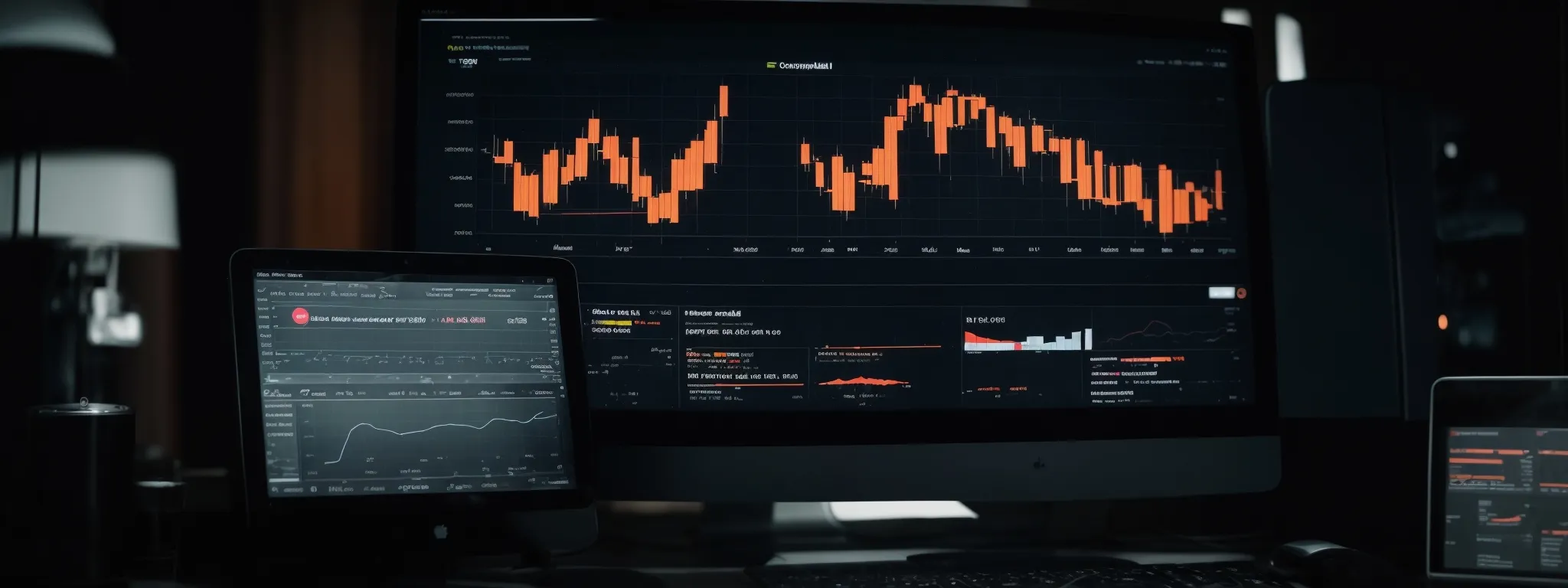Guide to Reputation Management
Mastering Your Online Presence: The Ultimate Guide to Reputation Management In the digital age, a robust online presence is vital for any entity, whether it’s a sprawling […]
Mastering Your Online Presence: The Ultimate Guide to Reputation Management
In the digital age, a robust online presence is vital for any entity, whether it’s a sprawling corporate entity, a mid-sized organization, or an individual carving out a professional niche.
Reputation management transcends mere crisis control; it’s a strategic approach to molding and maintaining the narrative around a brand, directly influencing trust and market value.
This guide illuminates the path to mastering online reputation management, from the bedrock of brand image to the advanced tactics of SEO reputation management and real-time monitoring.
It will equip readers with the tools and insights needed to elevate their brand’s digital standing and safeguard its integrity.
Keep reading to uncover how strategic reputation management could be the key to unlocking your brand’s full potential.
Key Takeaways
- Understanding Audience Perception Is Essential for Effective Online Reputation Management
- Setting Clear Goals and Having Measurable KPIs Is Crucial in Reputation Enhancement Efforts
- Proactive Engagement With the Audience Is Necessary for Shaping a Positive Brand Narrative
- Utilizing Reputation Management Tools Like LinkGraph and SearchAtlas by LinkGraph Is Beneficial for Monitoring and Improving Online Presence
- Legal Considerations and Swift Response to Defamation Are Important for Maintaining Brand Integrity
Crafting a Strong Foundation for Online Reputation Management

In today’s digital landscape, an organization’s success is largely influenced by its online reputation.
Crafting a robust foundation for online reputation management revolves around strategic steps that begin with an honest assessment of the current perception held by your audience.
By setting clear, actionable goals, a business positions itself to navigate the turbulent waters of public opinion.
Understanding your audience’s perception is not just about listening; it’s about discerning the subtleties of their feedback and the impact on your brand image.
Establishing a measurable baseline is crucial, for it serves as a compass that guides reputation enhancement efforts.
Each of these actions interlocks to form a comprehensive strategy, laying the groundwork for sustained improvement and a resilient positive presence in the digital realm.
Assessing Your Current Online Reputation
To embark on reputation management, an Initial Assessment of Your Current Online Reputation is essential. This evaluation involves a meticulous review of customer feedback, online reviews, and general sentiment expressed across various digital platforms, from social media to review sites. By doing so, an organization gains a clear picture of its online presence and brand reputation.
Collecting and analyzing this data underpins the strategy that will be used to bolster an organization’s digital image. Detailed insights are drawn from observing patterns in customer reviews and the frequency of discussions around the brand: are the conversations positive, negative, or neutral? This approach allows for a precise understanding of the perception surrounding the brand.
| Reputation Aspect | Positive Impact | Negative Impact | Neutral Impact |
|---|---|---|---|
| Online Reviews | Enhances trust and credibility | Deters potential customers | May imply satisfactory but unremarkable service |
| Social Media Sentiment | Fosters brand loyalty and community | Can lead to boycotts or PR crises | Indicates a need for stronger brand engagement |
| Customer Feedback | Guides product improvement and innovation | Reflects poor customer experience | Provides insights into consumer expectations |
Setting Clear Reputation Management Goals
Navigating online reputation management requires the establishment of precise, realistic objectives. An organization, understanding the current status of its reputation, must then articulate clear goals—such as improving customer satisfaction scores, reducing negative online mentions by a certain percentage, or increasing positive reviews on key platforms. These targets should align with broader marketing objectives and business strategies, ensuring consistency throughout the company’s digital PR services.
After setting these goals, it is imperative for an organization to put intricate plans in place capable of achieving them. This includes designating a competent team or hiring a reputable Reputation Management Company, deciding on timelines, and determining the key performance indicators that will measure progress. Such structured planning ensures that reputation management efforts are not only strategic but also measurable and adaptable to the evolving digital landscape.
Understanding Your Audience and Their Perceptions
Grasping the nuances of your audience’s perspectives is a cornerstone of reputation management. Armed with the understanding of their experiences and expectations, a brand can fortify its reputation by addressing the specific needs and concerns of its consumer base, actively shaping the narrative around its brand image.
Engaging with one’s audience goes beyond mere observation; it requires a proactive approach in gaining insights that inform strategic moves, ensuring that the brand resonates with its target audience on a deeper level. This approach helps to cultivate a loyal following and encourages positive exposure in the digital arena, helping to tip the scales in the organization’s favor.
Establishing a Baseline for Measuring Improvement
Establishing a baseline is a pivotal first step in effective reputation management, creating a quantifiable point of reference from which progress can be gauged. By identifying key metrics such as the volume of negative reviews, online sentiment scores, or search result rankings, an organization constructs a clear starting point to build upon.
With this foundational data in hand, the efficacy of reputation management strategies can be scrutinized over time, ensuring that initiatives are yielding the desired improvements. This consistent monitoring facilitates the adaptation of strategies to meet evolving challenges head-on, thus continuously optimizing a business’s online presence.
Building a Positive Image With Proactive Strategies

In the vast expanse of digital space, crafting and maintaining a favorable brand reputation requires deliberate and proactive strategies.
Central to these strategies is the ability to create narratives that resonate, to cultivate authentic interactions online, and to amplify the voices of those who have benefitted from a brand’s offerings.
Organizations must master the art of content creation, engage with their communities on social media platforms, harness the persuasive power of customer testimonials, and partner with influencers to broaden their reach.
By integrating these elements into their reputation management strategy, companies can effectively dictate the tenor of their brand conversations and set a course for enduring positive engagement.
Creating Valuable Content to Shape Your Narrative
The essence of a company’s digital narrative is often captured through the content it creates and disseminates. Quality, engaging content serves as the cornerstone that shapes public perception and fosters a connection with the target audience.
A dynamic content strategy leverages varied, informative, and thought-provoking materials to draw users in and keep them engaged: from informative blog posts to insightful case studies, content becomes the medium through which a brand’s story unfolds:
- Blog posts that highlight industry expertise
- Case studies showcasing success stories
- Videos that provide valuable how-to guides
- Infographics distilling complex information
- User-generated content that amplifies customer voices
By articulating a clear, consistent narrative through these various forms of content, organizations can significantly influence the conversation surrounding their brand. This proactive approach to content creation proactively shapes the brand’s online narrative and positions it favorably in the digital marketplace.
Engaging With Your Community Through Social Media
Engaging with your community through social media is a dynamic practice that transforms the online presence of any brand. By fostering direct conversations and actively listening to the audience on platforms like Facebook, Twitter, and Instagram, organizations can create a space for genuine interaction and customer connection.
Embracing this level of social media management allows a brand to respond promptly to inquiries, share valuable content, and express its corporate values. Through such engagements, a company can not only enhance its brand reputation but also demonstrate a commitment to excellence in customer service:
| Social Media Activity | Impact on Brand Reputation |
|---|---|
| Consistent Engagement | Builds Trust and Brand Loyalty |
| Responsive Customer Service | Improves Customer Satisfaction and Retention |
| Content Sharing | Increases Brand Visibility and Authority |
As digital spaces evolve, so too should the methods brands use to engage with their communities. By leveraging platforms where their target audience is most active, organizations maximize their sustainability within a competitive market, directly influencing their bottom line through increased digital exposure and audience loyalty.
Leveraging Customer Testimonials and Success Stories
Leveraging Customer Testimonials and Success Stories can significantly reinforce an organization’s reputation, serving as a testament to the quality and value of its offerings. These narratives, pulled from genuine experiences of satisfied users, form the backbone of trust that new customers seek before making a purchasing decision.
Success stories not only humanize a brand but also exemplify the company’s commitment to delivering positive customer experiences. When strategically shared across marketing channels, these powerful endorsements can elevate a company’s credibility and showcase its ability to meet and exceed expectations:
- Highlighting transformative user experiences through case studies.
- Featuring customer quotes that underscore product benefits and satisfaction.
- Sharing user-generated content that brings to life the practical application of services or products.
Collaborating With Influencers to Expand Reach
Engaging with influencers offers an avenue for brands to broaden their reach and reinforce their market position. Influencers, wielding substantial followings and trusted voices within their communities, can extend a brand’s visibility far beyond traditional marketing channels.
Through Strategic Partnerships, organizations benefit from the influencers’ credibility, as their endorsement serves to introduce and endorse the brand to a wider, yet highly targeted, audience. This effective collaboration catalyzes brand awareness and fortifies reputation across diverse user segments.
Monitoring Tools Essential for Reputation Management

Vigilant monitoring serves as the backbone of any successful online reputation management strategy, enabling organizations to stay ahead of the narrative shaping their brand image.
By employing the right combination of tools and techniques for real-time surveillance of their digital footprint, businesses can swiftly respond to brand mentions, track social media discussions, and analyze feedback from across various review platforms.
Proactive monitoring empowers companies to identify potential reputational risks, engage meaningfully with their audience, and refine their brand messaging, all of which are critical in building and maintaining a trusted online presence.
As companies navigate through the available options for reputation management software, set up Google Alerts, scour social networks, and sift through online reviews, they craft a safety net that captures the pulse of public sentiment, ensuring they are always informed and ready to act.
Choosing the Right Reputation Management Software
Choosing the right reputation management software is a pivotal decision for any business keen on crafting a positive online presence. It’s essential to select a platform that not only tracks mentions and reviews but also provides actionable insights to shape your reputation strategy.
When carving out a niche in the digital marketing landscape, LinkGraph and the SearchAtlas SEO software emerge as distinguished options: they supply organizations with an assortment of analytical tools imperative for a comprehensive understanding of their online standing.
- LinkGraph offers an intuitive reputation management tool that systematically analyses online mentions, enabling businesses to pinpoint and respond to areas impacting their brand image.
- The SearchAtlas SEO software extends beyond traditional monitoring, offering features designed to optimize content and enhance SERP positions, thus bolstering the overall brand reputation.
Implementing such sophisticated platforms ultimately shapes the caliber of an organization’s online reputation management, ensuring that their efforts are proactive, informed, and strategically aligned with their digital PR goals.
Setting Up Google Alerts for Brand Mentions
Staying abreast of brand mentions is paramount in reputation management, and setting up Google Alerts is a straightforward yet effective method to achieve this. By supplementing reputation management software with Google Alerts, an organization ensures comprehensive coverage of its brand mentions in real time.
Upon configuring Google Alerts for specific brand-related keywords, businesses receive notifications whenever new content surfaces that matches these terms: an essential tool for monitoring what’s being said about the brand online. Utilizing alerts can inform a company’s rapid response strategy, allowing them to address any emerging issues swiftly and maintain a positive brand image:
- Define crucial brand-related keywords and set up Google Alerts for each.
- Customize alert settings to specify the frequency and types of content to be monitored.
- Review alerts to rapidly address any negative mentions and amplify positive narratives.
By integrating Google Alerts into their digital arsenal, savvy businesses can keep their finger on the pulse of their online reputation, making it an indispensable component of their broader reputation management strategy.
Tracking Social Media Conversations and Trends
Tracking social media conversations and trends is a critical function of a reputation management strategy, offering organizations a lens into real-time public opinion and social commentary. Through vigilant observation of these social spaces, businesses keep up with the fast-paced nature of social networks, receiving immediate insight into both customer sentiment and emerging trends that may affect their brand.
Employing Tracking Tools, organizations can actively monitor brand mentions, hashtags, and topical discussions related to their industry, facilitating swift and informed responses to conversations that matter the most. This proactive engagement not only enhances brand relevancy but also fosters a stronger connection with the target audience:
- Utilize tracking tools to identify and engage in relevant social media conversations.
- Monitor hashtags and trends to remain at the forefront of industry discussions.
- Leverage insights gathered from social interactions to refine marketing strategies.
Analyzing Online Reviews Across Multiple Platforms
Analyzing online reviews across multiple platforms is a critical exercise in understanding the multifaceted perceptions of a brand. This analysis involves a deep dive into customer experiences and sentiments shared on various platforms, ranging from major review sites to niche forums, providing organizations with a holistic view of their standing with consumers.
Accurate interpretation of these reviews can unearth patterns and insights that are instrumental for constructing effective response strategies. The gathered intelligence informs organizations on where to focus their reputation management efforts and helps prioritize the action steps for enhancing their overall online presence.
Responding to Negative Feedback Effectively

Managing an online presence is a meticulous task that demands vigilance, especially in the face of negative feedback.
The ability to respond to criticism with poise is not just an act of damage control; it’s an opportunity for growth and improved customer relations.
Effective reputation management hinges on a company’s ability to architect a professional response plan that addresses concerns, embraces transparency, and communicates a commitment to customer satisfaction.
Embracing this aspect of digital marketing solutions, organizations can transform negative comments into catalysts for positive change, demonstrate their dedication through conscientious follow-ups, and refine their operations by actively listening to their clientele.
This approach is not only remedial but anticipatory, preparing businesses to preempt future issues and cement a foundation of trust with their audience.
Crafting a Professional Response Plan
Assembling a professional response plan is a critical facet of an organization’s reputation management strategy, signaling its readiness to address consumer grievances with grace and accountability. The blueprint of such a plan lays out the protocols for acknowledging customer feedback swiftly, ensuring that each interaction is handled with the appropriate tone and remedies, reflective of the brand’s values and commitment to excellence in service.
An adept response plan not only directs the course of communication in the aftermath of negative feedback but evokes confidence in the customer base by showcasing the organization’s dedication to rectifying issues and upholding customer satisfaction. It acts as a guiding framework for the brand reputation management team to navigate through moments of crisis seamlessly and convert challenges into opportunities to reinforce customer trust and loyalty.
Turning Negative Comments Into Positive Change
Embracing negative feedback as a catalyst for improvement is imperative within the landscape of online reputation management. By systematically dissecting each piece of criticism, an organization can identify core issues that may need attention and initiate targeted reforms that enhance both brand image and customer experience. This strategy allows businesses to pivot from defense to offense, transforming potentially damaging scenarios into compelling narratives that underscore their commitment to continuous improvement and customer-centric values.
Organizations that skillfully navigate the terrain of negative comments can leverage such encounters to demonstrate transparency, accountability, and a proactive approach to customer care. Acknowledging the areas where customer expectations may not have been met, promptly addressing concerns, and openly communicating the steps taken to rectify the situation, collectively serve to fortify public trust. This transparent method of dealing with criticism not only remedies individual grievances but also strengthens the foundation of brand credibility and loyalty amongst the wider audience.
Following Up to Demonstrate Commitment to Satisfaction
In the realm of reputation management, the follow-up is a strategic gesture that communicates to customers the company’s dedication to their satisfaction. Closing the loop after addressing a negative comment or review is a tangible demonstration of the organization’s commitment to service excellence.
This continuous engagement, where resolution and satisfaction are not just assured but also verified, shapes customer perceptions and bolsters confidence in the brand. The outcome is twofold: existing customers feel valued, and potential customers gain assurance about the organization’s reliability:
- Implementing a structured follow-up process to ensure resolutions meet customer expectations.
- Using customer feedback as a springboard for refining customer service protocols and product enhancements.
- Building a reputation for accountability that attracts new customers and retains existing ones.
Preventing Future Issues Through Active Listening
Preventive measures are paramount in reputation management, and active listening serves as the cornerstone for preempting future complications. By closely attending to the undercurrents of customer dialogue and extracting actionable insights, an organization equips itself to preemptively address issues before they escalate into more substantial challenges.
Through this vigilant and proactive approach, companies not only anticipate potential risks, but they also affirm their commitment to their clientele. Active listening fosters a culture of responsiveness, where customer concerns are not merely heard but also acted upon, leading to a more cohesive and anticipatory approach to maintaining a positive online presence.
Harnessing the Power of SEO for Reputation Management

In the digital realm where visibility equates to viability, search engine optimization (SEO) becomes a critical instrument in reputation management.
Mastering your online presence requires not only an agile approach to content optimization for better search visibility but also a strategic handling of online reviews to enhance search rankings.
By proficiently using keywords, brands can effectively dominate positive mentions and construct an authoritative narrative in search engine results pages (SERPs).
Moreover, it is essential to understand the ways to counteract negative SEO and mitigate its possible detrimental impact on a brand’s standing.
Aligning SEO efforts with reputation management can significantly propel an organization forward, turning the vast digital marketplace into a stage for showcasing trust and credibility.
Optimizing Your Content for Better Search Visibility
Enhancing search visibility is an art that necessitates the strategic deployment of SEO content optimization. By integrating well-researched keywords into website content, brands effectively signal to search engines the relevance and authority of their digital assets, thereby climbing the SERPs and capturing the attention of their target audience.
An optimized web domain resounds across the virtual landscape, pulling in organic traffic through Meticulous Crafting of Meta Descriptions, titles, and headers that mirror the search patterns of users. This optimization ensures that positive content gets the spotlight, solidifying the foundation of a company’s online reputation.
Managing Online Reviews to Improve Search Rankings
Attentive management of online reviews is a silent yet potent actor in the realm of SEO, with its influence extending to search rankings. An aggregation of positive reviews can work wonders, signaling to search engines a business’s credibility and consumer satisfaction, thus meriting higher placements in search results.
Regularly soliciting customer reviews and tactfully addressing negative feedback contribute to a rich tapestry of social proof that search algorithms favor. This web of authentic customer endorsements enhances visibility, cultivating an online atmosphere that prioritizes trustworthiness and consumer loyalty:
- Actively request reviews from satisfied customers to build a volume of positive feedback.
- Engage with reviews professionally, resolving issues to show a responsive and customer-centric brand attitude.
- Leverage positive reviews across marketing channels to underscore brand reliability and service quality.
Using Keywords to Dominate Positive Brand Mentions
Strategically utilizing keywords within digital content can significantly augment an organization’s ability to command a preeminent position in brand mentions. By identifying and embedding targeted keywords related to their brand and offerings, organizations can craft content that ranks prominently on search engine results pages, spotlighting the positive aspects of their online persona.
As brands concentrate on weaving these focused keywords into their digital narratives, they create a cohesive and discoverable brand story. This targeted keyword usage enhances visibility for positive mentions, crowding out less favorable content, and ensuring that potential and current customers encounter a brand’s best foot forward in the digital space.
Dealing With Negative SEO and Its Impact on Reputation
Negative SEO presents a dire threat to any organization’s online stature, as it involves malicious tactics aimed at diminishing a brand’s search engine rankings.
Businesses must remain vigilant and equipped with robust digital marketing solutions like LinkGraph and SearchAtlas SEO software to swiftly identify and counteract these detrimental actions, ensuring their reputation remains untarnished in the digital ecosystem.
Legal Considerations in Managing Your Online Reputation

As organizations endeavor to sculpt their digital persona, legal considerations become an indispensable segment of online reputation management.
Grappling with the implications of defamation involves understanding its mechanisms and identifying the right course of action to mitigate its impact.
Furthermore, knowing the appropriate circumstances under which to request content takedowns is vital for maintaining brand integrity.
Equally critical is navigating the nuances of the Right to Be Forgotten legislation, a pivotal aspect of reputational control within certain jurisdictions.
This preemptive legal acumen is crucial for organizations to shield their online presence from potential harm and ensure their digital footprint aligns with their desired brand narrative.
Understanding Defamation and How to Address It
Defamation in the digital realm represents a critical obstacle that can undermine an organization’s reputation, often manifesting as false statements made publicly with the intent to damage the brand. To address defamation, it is essential for a company to identify the source of such claims and assess the legitimacy and potential impact on their reputation.
A robust response to defamation typically involves legal avenues, including the issuance of cease and desist letters or pursuing litigation. However, before taking legal action, an organization must ensure that the defamation has indeed occurred and that the claim cannot be defended as an opinion or truthful statement:
| Action | Purpose | Outcome |
|---|---|---|
| Identify Source | Ascertain origin of defamation | Focus response efforts |
| Legal Consultation | Determine validity of defamation claim | Inform course of action |
| Issue Cease and Desist | Curtail further dissemination of defamatory content | Potential resolution without litigation |
| Pursue Litigation | Seek legal redress and compensation for damages | Restoration of reputation and deterrence of future defamation |
Escalating responses to defamation must be carefully considered, as they can impact public perception further. Should litigation be pursued, it must be undertaken with a clear understanding of the potential repercussions on the organization’s image and the long-term effects on its online presence.
Knowing When to Request Content Takedowns
Discerning the opportune moment to request the removal of online content is a nuanced aspect of safeguarding an organization’s reputation. It hinges upon the material being undeniably harmful or inaccurate, and unequivocally infringing on the brand’s intellectual property rights or privacy concerns.
Upon ascertaining that content could materially damage an entity’s reputation or breach legal statutes, swift recourse to content takedown requests is warranted. This action should be pursued Through Official Channels, with the goal of efficiently expunging the problematic content from the digital sphere:
| Content Issue | Legal Consideration | Action to Take |
|---|---|---|
| Defamatory Material | Breach of Defamation Laws | Request for Removal |
| Infringement of Privacy | Violation of Privacy Rights | Cease and Desist & Takedown Notice |
| Unauthorized Use of Intellectual Property | Intellectual Property Rights Infringement | DMCA Takedown |
Should these requests meet resistance or fail to yield the desired result, an organization must be prepared to escalate the matter legally to protect its online reputation and uphold its rights.
Navigating the Right to Be Forgotten Legislation
Navigating the intricacies of the Right to Be Forgotten legislation is an integral task for any organization diligent about managing its online reputation. Focused predominantly within the European Union, the statute endows individuals with the authority to request the deletion of personal data under specific circumstances, an aspect that can significantly affect how a company handles personal information online.
Companies must approach the Right to Be Forgotten with a well-defined protocol, ensuring compliance with legal requirements while balancing the need to maintain online information that serves the public interest. It’s imperative that these entities have precise mechanisms in place to evaluate and act upon requests, all the while safeguarding their online reputation through transparent and legal conduct.
Measuring the Success of Your Reputation Management Efforts

In the pursuit of excellence in online reputation management, the effectiveness of an organization’s efforts must be quantifiable to ascertain true success.
It is critical to identify the correct Key Performance Indicators (KPIs) that track and reflect the health of a brand’s digital standing.
Utilizing advanced analytics, companies can measure public sentiment with precision and reassess their strategies based on these insights.
By continuously adjusting actions and tactics in response to quantifiable metrics and consumer feedback, businesses can navigate the complexities of the digital world with confidence.
Achieving this nuanced balance empowers organizations to steadfastly protect and enhance their online reputation.
Identifying Key Performance Indicators (KPIs) for Reputation
Identifying Key Performance Indicators (KPIs) is instrumental in assessing the efficacy of reputation management initiatives. By maintaining a set of specific, quantifiable metrics, an organization can track the evolution of its reputation over time, gaining valuable insights into the effectiveness of its strategies.
These indicators reflect various facets of a brand’s digital presence, including customer sentiment, engagement levels, and online visibility:
- Volume of positive versus negative sentiment in customer feedback.
- Response rate and resolution success for customer complaints.
- Changes in brand mentions and their sentiment across social media.
- Fluctuations in search engine rankings for branded keywords.
- Growth rate of positive online reviews on prominent platforms.
Continuous analysis of these KPIs allows organizations to course-correct their reputation management tactics proactively, ensuring ongoing improvement in their online standing. It equips brand reputation managers to tailor their strategies to meet the evolving expectations of their audience and industry trends.
Utilizing Analytics to Gauge Public Sentiment
Expertly leveraging analytics is fundamental to comprehending public sentiment as part of any sophisticated reputation management framework. Modern reputation management software is designed to sift through the vast expanse of digital chatter, extracting meaningful patterns and discernible trends from across social media platforms, review sites, and more, to deliver a granular view of the audience’s feelings towards the brand.
Advanced Algorithms and Sentiment Analysis Tools within platforms like SearchAtlas by LinkGraph provide organizations with the capability to quantitatively parse public emotion. By harnessing these insights, companies gain an invaluable understanding of their brand’s reception, enabling them to strategically pivot their engagement practices and communication efforts to align with, and positively influence, consumer sentiment.
Adjusting Your Strategy Based on Metrics and Feedback
Recognizing the dynamic nature of the digital environment, organizations must readily adjust their reputation management strategy in response to the feedback and metrics garnered through their efforts. An agile approach embraces the fluidity of consumer sentiment, permitting companies to fine-tune their methods to better serve their audience and enhance their brand image.
Armed with data-driven insights, brands are poised to act decisively, recalibrating their approach to reputation management to capitalize on their strengths and address their weaknesses. This proactive strategy involves refining communication tactics, customer engagement, and content distribution to bolster the brand’s standing and rectify areas highlighted by feedback:
| Metric | Insight | Action Taken |
|---|---|---|
| Customer Satisfaction Scores | Identifies areas needing improvement | Implement targeted service enhancements |
| Negative Mention Trends | Reveals specific pain points | Strategize specific response protocols |
| Review Volume and Quality | Indicates brand perception | Improve review solicitation strategies |
Ultimately, an organization that adapts its reputation management strategy based on concrete metrics and constructive feedback is positioned to thrive. It solidifies its proactive stance in the digital marketplace, consistently shaping a positive online presence that resonates with both current and potential customers.
The Future of Online Reputation Management

As the digital environment continues its rapid evolution, mastering one’s online presence has become a sophisticated dance with technology and public perception.
The landscape of online reputation management is undergoing a transformation, fuelled by emerging digital trends and the burgeoning influence of artificial intelligence.
Businesses must prepare for a paradigm shift in reputation management strategies, ensuring they not only keep pace with but also fully leverage advancements such as AI, new media, and platform integration.
Recognizing the shifts in consumer behavior is paramount, as organizations anticipate and adeptly respond to the changing tides, crafting a strategy that is resilient, responsive, and in tune with tomorrow’s digital milieu.
Keeping Up With Evolving Digital Trends
As the digital marketing landscape shifts, it becomes increasingly vital for organizations to stay attuned to the latest developments that shape consumer engagement and online narratives. Recognizing and embracing these trends are essential for ensuring that reputation management strategies are current, effective, and capable of reaching an ever-more discerning audience.
Integrating emerging technologies and keeping an observant eye on platform changes allows companies to remain proactive in their digital marketing efforts. Successful reputation management in this context demands agility and foresight, staying abreast of digital drivers that impact how brands are perceived and engaged with online.
Preparing for the Impact of AI on Reputation Management
The integration of artificial intelligence into reputation management heralds a new frontier for organizations keen on cultivating an unblemished online presence. As AI technologies mature, they endow brand reputation managers with sophisticated analytical tools that anticipate public sentiment shifts and automate the monitoring of brand mentions across diverse digital mediums.
Businesses poised to embrace the capabilities of AI will find themselves at a competitive advantage, equipped to analyze vast datasets and implement nuanced strategies at unprecedented speeds. The employment of AI-driven reputation management will empower companies with predictive insights, enabling a preemptive approach to safeguarding and enhancing their digital reputation.
Integrating New Media and Platforms Into Your Strategy
Embracing new media and incorporating emerging platforms into a reputation management strategy is no longer optional; it’s imperative. As consumers flock to innovative channels, organizations must harness these fresh avenues to distribute content, engage audiences, and monitor brand conversations, ensuring their narrative evolves with the technological landscape.
Through a systematic integration of new media options, companies can expand their digital footprint, reaching into corners of the online world previously untouched. This strategic expansion into novel platforms not only diversifies an organization’s presence but also enriches its capability to connect with diverse segments of its target audience, reinforcing the strength and reach of its brand reputation.
Anticipating and Adapting to Changes in Consumer Behavior
Anticipating shifts in consumer behavior is an essential aspect of online reputation management that requires a blend of insightful analysis and agile methodology. As customer preferences and digital interaction patterns evolve, organizations need to continuously monitor and adjust their engagement strategies to align with consumer expectations and maintain a positive brand image.
Organizations that excel at adapting to changes in consumer behavior position themselves to proactively manage their reputations. These entities leverage actionable data, derived from ongoing analysis, to fine-tune their communication tactics, ensuring relevance and resonance with their audience, thereby safeguarding their online standing in an ever-changing digital marketplace.
Conclusion
Mastering your online presence through effective reputation management is essential for any organization seeking to thrive in today’s digital-dominated world.
A well-crafted strategy enables businesses to navigate the complexities of public perception by establishing a strong foundation that begins with a thorough assessment of the current online reputation.
Setting clear, measurable goals, understanding audience perceptions, and establishing a baseline for improvement are crucial steps in crafting a robust reputation management framework.
Proactive strategies, such as engaging with communities on social media, creating valuable content, leveraging customer testimonials, and collaborating with influencers can significantly enhance a brand’s image.
Additionally, utilizing monitoring tools to track digital conversations and responding effectively to negative feedback help maintain a positive reputation.
Integrating SEO strengthens online visibility and adopting legal considerations prevents potential harm.
Measuring the success of these efforts using KPIs and adjusting strategies based on analytics ensure that an organization can responsively tune its reputation management practices.
As digital trends evolve, preparing for the impact of AI, integrating new media, and anticipating changes in consumer behavior are key for future-proofing reputation management efforts.
Ultimately, by mastering their online presence, organizations protect and elevate their brand’s reputation, fostering trust and credibility in the digital marketplace.



















































































